|
|
|
Sort Order |
|
|
|
Items / Page
|
|
|
|
|
|
|
| Srl | Item |
| 1 |
ID:
103133


|
|
|
|
|
| Publication |
2009.
|
| Summary/Abstract |
The reconstruction of Afghanistan is in part dependent upon the reintegration of Afghanistan into the international community. Reintegration, in turn, is dependent upon Afghanistan's trans-border infrastructure of communication, trade, transport, water, power and investment. Accordingly, increased regional economic cooperation is a key element of Afghanistan's reconstruction. This article analyses regional economic cooperation in the South and Central Asian region in terms of logic, institutions, actors, and expectations. The article argues in favour of inclusiveness to enlarge the number of beneficiaries of economic benefits of regional economic cooperation while avoiding the pitfalls of risky strategies of faulty collective action.
|
|
|
|
|
|
|
|
|
|
|
|
|
|
|
|
| 2 |
ID:
166663
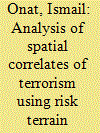

|
|
|
|
|
| Summary/Abstract |
The purpose of this study is to identify correlates of terrorism in space. It examines whether places with terrorist incidents show similar patterns with respect to the physical features across landscape, and tests the spatial influence of various features of environment on the incidence of terrorism. Drawing on the locations of violent terrorist offenses committed between 2008 and 2012, the study in Istanbul applies the Risk Terrain Modeling framework to terrorism. It uses data on police incidents and infrastructure (e.g., government buildings or parks). The analysis employs GIS techniques and an event count model, and combines all risky layers in a composite map to understand where the risk is higher. The study suggests a concentration of 1153 violent terrorist incidents relative to key physical factors by identifying seventeen potential risk factors, eight of which were significantly correlated in the model. Regardless of terrorists’ intent, the significantly associated establishments increase the risk in the surrounding areas where these features are located. The coexistence of leisure places such as bakeries, religious facilities, or eateries results in higher risks. While the environmental backcloth may constitute a risk for terrorism, its components may also help forecast the locations of terrorist incidents in the future.
|
|
|
|
|
|
|
|
|
|
|
|
|
|
|
|
| 3 |
ID:
163831
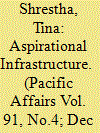

|
|
|
|
|
| Summary/Abstract |
This article contributes to the current scholarship on migration brokerage and infrastructure by revealing the contingent, experimental, and dynamic nature of recruiting work for foreign-employment recruitment agencies (FERAs) in Nepal. By situating Nepal’s migration infrastructure, or foreign employment (baidesik rojgar), within the nation’s social history and long-standing discourse on development (bikas), this paper argues for the importance of tracing the experimental character of an emergent migration infrastructure. In particular, I develop the concept of “aspirational infrastructure,” by which I mean the oft-overlooked experimental practices and practicalities that shape and direct the aspirations of those involved in foreign-employment recruitment work. The ethnography traces the intense encounter, intermediation, and interaction among the actors engaged in brokerage activities at FERA social spaces, where recruiters shape not only the social imaginaries and aspirations of potential migrants, but also their own. The recruitment work and migration brokerage rely on balancing the renewed vision and familiar discourse surrounding the “promise of livelihood,” and the reconfiguration of existing institutional norms, ultimately serving the state’s reprioritization of maintaining its “developing” status.
|
|
|
|
|
|
|
|
|
|
|
|
|
|
|
|
| 4 |
ID:
148622
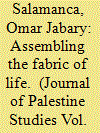

|
|
|
|
|
| Summary/Abstract |
This article brings attention to the political geography of settler colonialism and the ways in which the Palestinian built environment materializes in space, consolidating uneven and racialized landscapes. It argues that settler-colonial space is intimately related to the building of infrastructures structured by development and humanitarian practices. More specifically, the discussion explores how roadscapes are materially and symbolically constructed; it also examines the ways in which development, rather than constituting a tool of empowerment, becomes a mechanism to manage the short-term "humanitarian" needs of Palestinians that arise from the imperatives of settler colonialism. Problematizing road infrastructure allows us to explore the relationship between Palestinian and donor agendas, and concomitant discourses on economic development and state building; in other words, how settler infrastructures are normalized through their association with tropes of modernity, progress, humanitarianism, and development.
|
|
|
|
|
|
|
|
|
|
|
|
|
|
|
|
| 5 |
ID:
178342
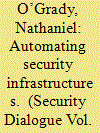

|
|
|
|
|
| Summary/Abstract |
This article contributes to emergent debates in critical security studies that consider the processes and effects that arise where new forms of automated technology begin to guide security practices. It does so through research into public Wi-Fi infrastructure that has started to appear across the globe and its mobilization as a device for warning the public about emergencies. I focus specifically on an iteration of this infrastructure developing in New York called LinkNYC. According to the infrastructure’s operators, the processes that underpin emergency communication have gradually become ‘automated’ to accelerate LinkNYC’s deployment during crises. The article pursues three lines of inquiry to explore the automation of security infrastructure, in turn making three correspondent original contributions to wider debates. First, it unpacks the real-time analytics and platform-based data-sharing techniques cultivated to automate emergency communication. Here, I expand understanding of the new forms of automation now integrated into technologies harnessed for security and their practical effects. These forms of automation, I demonstrate secondly, are situated by those governing into wider imaginaries concerning the transformative promise automation bears. I argue that the proliferation of these imaginaries play a crucial role in justifying and dictating the enrolment of new devices into security. Third, it explores how automation affords private companies the opportunity to exercise discretionary decisionmaking that changes how and when infrastructure should operate during emergencies. Developing this argument, I add new dimensions to debates regarding the political ramifications associated with automation by claiming that automation redistributes authority across the public and private organizations that increasingly coordinate in bringing new technologies to bear in the security domain.
|
|
|
|
|
|
|
|
|
|
|
|
|
|
|
|
| 6 |
ID:
152241
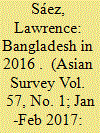

|
|
|
|
|
| Summary/Abstract |
The year 2016 was challenging for Bangladesh. Although there are promising signs of a transition toward upper lower-income status, there is sufficient political instability at the margins to warrant concern. The capstone political event was the July terrorist attack in Dhaka, which many feared might represent the first clear metastasized imprint of the Islamic State (ISIS) in Bangladesh.
|
|
|
|
|
|
|
|
|
|
|
|
|
|
|
|
| 7 |
ID:
185169


|
|
|
|
|
| Summary/Abstract |
Australia has not been alone in declining the opportunity to take part in China's Belt & Road Initiative (BRI). Instead, this article contends, Australia launched its own infrastructure initiative in the Pacific that has attempted to reduce the attractiveness of the BRI to the region. The article focuses on Australia’s intervention in the Coral Sea Cable System, an action which vastly reduced the role of Chinese firms such as Huawei in building telecommunications infrastructure in the Pacific. Informed by a postcolonial perspective, we explain Australia’s stance on the BRI in terms of its intimate but at-times problematic relations with Asia and the Pacific. This was reflected in Australia’s unwillingness to acknowledge the legitimacy of the BRI as a foreign policy initiative, in its invocation of the ‘rules-based order’ to justify its intervention in the cable project, and in the design of its regional infrastructure program, which bore some uncanny resemblances to what Australian policymakers have depicted as the worst aspects of the BRI itself.
|
|
|
|
|
|
|
|
|
|
|
|
|
|
|
|
| 8 |
ID:
182693


|
|
|
|
|
| Summary/Abstract |
Although infrastructures may be material manifestations of state territorial power, the political effects of infrastructures are seldom straightforward. And yet, many accounts of the Belt and Road Initiative (BRI) assume a relatively conventional approach to politics, and to political power. Geopolitical intentionality and top-down policy and strategic planning tend to be emphasised over project-level analyses. In response to what might be viewed as an invented BRI geopolitics, this essay suggests a more technopolitical framing of the Belt and Road and seeks to apply an infrastructural analytic to the question of how political power is realised or frustrated, enhanced or diverted, by the distributed and relational nature of infrastructure projects. It argues that our understanding of the socio-technical complexities of infrastructure is poorly served by viewing them through a conventional geopolitical lens. Instead, it seeks to lay out a research agenda and analytical framework for addressing the questions of how infrastructure projects grow and evolve, how they are embedded within the social-political-cultural contexts in which they develop and how they produce political effects that at times align with broader-scale geopolitical agendas and at other times do not.
|
|
|
|
|
|
|
|
|
|
|
|
|
|
|
|
| 9 |
ID:
155247


|
|
|
|
|
| Summary/Abstract |
This paper analyzes the impact of the Belt and Road Initiative on Europe with a specific focus on Italy. We concentrate on the impact of new railways and port infrastructures on bilateral trade. Our analysis suggests that the development of new railway connections will benefit most of the Northern and Central European countries. Some industries like automotive and electronics that have a higher value to weight ratio will benefit more than others. However, due to higher costs, railway services will never reach a high percentage of total import/export flows. Investment in new port facilities, although less “new” compared with railways, may be a bigger game changer. The development of the Port of Piraeus has already increased the importance of the Mediterranean Sea as an import/export hub for China. If the other planned investments in Egypt and Algeria are completed, this phenomenon will be magnified. This presents a huge challenge for Italy. The Italian port in the high Adriatic Sea could be displaced by Piraeus capacity, especially if this port is linked through railways with the center of Europe. Italy needs to coordinate its ports together with its railway network to take advantage of Belt and Road Initiative opportunities.
|
|
|
|
|
|
|
|
|
|
|
|
|
|
|
|
| 10 |
ID:
174203
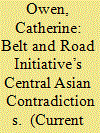

|
|
|
|
|
| Summary/Abstract |
This essay considers the nature of China’s Belt and Road Initiative (BRI) in Central Asia. Rather than a “grand strategy” coordinated by Beijing, it is better seen as a decentered, contradictory network of transnational clientelist relationships and semiautonomous profit-seeking institutions. While building much-needed infrastructure, these projects serve to enrich local political elites while fueling resentment and suspicion among their populations. Evidence for this argument is presented from three spheres: the principal implementers of the BRI, the main projects that have been enacted under its auspices in Central Asia, and examples of how these projects have been marred by elite corruption and local protest.
|
|
|
|
|
|
|
|
|
|
|
|
|
|
|
|
| 11 |
ID:
170622
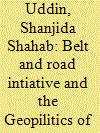

|
|
|
|
|
| Summary/Abstract |
This paper examines how China’s latest mega plan – the Belt and Road Initiative (BRI) will influence the geopolitics of energy. With a massive change in global energy supply and demand, the transition of international energy order is in the making. While the USA is going towards more isolationist path from its traditional superpower role, there are growing economies such as China, India, Japan and Russia which are undoubtedly playing important role on geopolitical stage. Several regions such as Central Asia, the Arctic, Eastern Mediterranean and South China Sea are offering huge natural gas and oil reserves and drawing global attention to develop energy cooperation. This situation is profoundly influencing the transition of energy order. In this transition, BRI is supposed to play an important role. As a mega development strategy with strong geostrategic dimension, it aims at promoting interconnectivity and cooperation in infrastructure, trade and development among the participating countries. This mega plan offers plenty of investments, infrastructure constructions and industrial integration in the energy sector. In addition, China is trying to build alternative energy shipping routes for evading heavy dependence on traditional energy chokepoints, specifically on the Strait of Malacca. In doing so, the country is trying to establish a multilateral platform for promoting and protecting energy cooperation under BRI. This paper, therefore, attempts to observe how this mega plan will contribute in re-shaping the existing energy order as well as the geopolitics of energy with a focus on multilateral energy cooperation.
|
|
|
|
|
|
|
|
|
|
|
|
|
|
|
|
| 12 |
ID:
177528
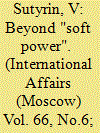

|
|
|
|
|
| Summary/Abstract |
AT THE TURN of the 1990s, when the bipolar world order had fallen apart and the U.S. and the EU had launched their expansionist foreign policy, the West simultaneously formulated the "soft power" concept1 and reissued, so to speak, the philosophical idea of civil society.2 It was a new form of substantiating democracy designed to apply Western patterns in post-socialist societies through nongovernment organizations (NGOs) as agents at the middle and low levels.
|
|
|
|
|
|
|
|
|
|
|
|
|
|
|
|
| 13 |
ID:
180313
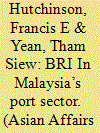

|
|
|
|
|
| Summary/Abstract |
The Belt and Road Initiative (BRI) has been characterised as a large-scale initiative to boost the movement of goods and services, capital, and people from China to Southeast Asia and beyond. Transport and logistics are a key aspect of this enterprise, with many projects focussing on railways, road networks, and ports receiving priority attention. However, BRI-related initiatives are often cast in unitary terms, with agency and autonomy almost uniquely ascribed to China-based firms and funders, and very little attributed to host country agents or their interests. Since 2013, Malaysia has received substantial inflows of BRI-related funds for infrastructure, particularly railways and ports. The Kuantan Port Expansion on Peninsular Malaysia's East Coast and the Melaka Gateway on its West Coast are two port-centred development projects associated with the BRI. Begun at the same time, these initiatives are similarly structured, as joint ventures linking large China-based state-owned enterprises with local players. Despite their similarities, these two projects have followed vastly different trajectories. While the Kuantan Port Expansion is proceeding according to schedule, the Melaka Gateway lies mired in delays and controversy. Through comparing and contrasting these two projects, this article will explore how – despite China's financial and political influence – host country actors can and do oppose, subvert, and even veto infrastructure initiatives perceived as inimical to their interests.
|
|
|
|
|
|
|
|
|
|
|
|
|
|
|
|
| 14 |
ID:
177617
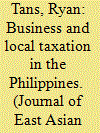

|
|
|
|
|
| Summary/Abstract |
This article argues that weak local governments increase levels of taxation by “borrowing” institutional capacity from certain types of businesses. While many businesses lobby against taxation, businesses that are locally owned, nationally connected, and logistically complex build robust associations that support taxation. These types of businesses benefit from improvements in public infrastructure, so they empower their associations to monitor members’ tax compliance and to pressure officials to uphold their spending commitments. The article demonstrates the necessity of business support for taxation in the absence of state capacity by comparing two Philippine cities that differ in their ability to tax despite a number of similarities between them. The case studies show that tax increases co-varied with business support, and that business support waxed and waned depending on over-time variation in the capability of business associations to discourage tax evasion and to enforce official commitments to spend on infrastructure.
|
|
|
|
|
|
|
|
|
|
|
|
|
|
|
|
| 15 |
ID:
120029
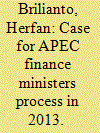

|
|
|
| 16 |
ID:
180650
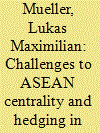

|
|
|
|
|
| Summary/Abstract |
Since 2010, ASEAN has made efforts to increase its coherence and visibility as an actor in regional infrastructure development, under the umbrella term of connectivity. Its most recent strategy, 2016’s Master Plan on ASEAN Connectivity 2025, is notable for its more focused agenda as well as a tableau of institutional innovations, including new policy coordination mechanisms and a project preparation pipeline. Nonetheless, ASEAN struggles to maintain coherence in the implementation of its connectivity agenda, both internally as well as towards its dialogue partners. Utilizing the concepts of centrality and hedging as parts of a unified theoretical framework, this paper analyzes ASEAN’s efforts to mobilize and manage external resources in connectivity. ASEAN’s resource dependence and its failure to establish institutional centrality creates issues at the regional and the national levels. Regionally, ASEAN’s lack of centrality and its perpetuation of ASEAN+1 relations have contributed to the emergence of contesting agendas and institutional frameworks by external actors. Nationally, the hedging strategies of ASEAN member states are at odds with the regional vision, highlighting a lack of intra-ASEAN coherence. The perpetuation of contesting institutional frameworks by external actors at the national level solidifies existing incoherence in ASEAN’s connectivity governance, further undermining its centrality. ASEAN’s efforts to assert centrality and execute a hedging strategy in connectivity are emblematic of its attempts to extend its reach into new policy areas, but also of its persistent governance constraints.
|
|
|
|
|
|
|
|
|
|
|
|
|
|
|
|
| 17 |
ID:
144908
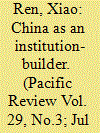

|
|
|
|
|
| Summary/Abstract |
As China is entering into the center stage of the world arena, it has become more proactive in regional and global institution-building. Globally, it has been actively involved in the G20 affairs and will be hosting the 2016 G20 Summit in Hangzhou. Regionally, it came up with a major initiative for a new institution, namely, the Asian Infrastructure Investment Bank (AIIB). This article aims to analyze the new institution's formation, goals and institutional arrangements as well as its implications.
|
|
|
|
|
|
|
|
|
|
|
|
|
|
|
|
| 18 |
ID:
184396
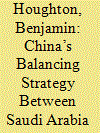

|
|
|
|
|
| Summary/Abstract |
Since Deng Xiaoping's opening-up policy and drive for economic modernisation and reform in the late 1970s, and especially since China's foreign energy requirements skyrocketed in 1993, Beijing's interests in the Persian Gulf have grown immensely. A staple of its regional policy has been an insistence on cultivating relations with all states, something that has necessitated a careful balancing act between regional rivals, especially Saudi Arabia and Iran. This article examines China's strategy to balance relations with these two states, especially during periods of tension, such as following the 2019 drone attacks on Saudi oil facilities, something that Riyadh accused Iran of masterminding. Following an examination of this strategy, the article explores Saudi attempts to coax Beijing away from Tehran and Saudi perceptions of Sino-Iranian relations through the lens of the 2021 25-year agreement between China and Iran, questioning whether Sino-Iranian relations are a bone of contention in Sino-Saudi relations.
|
|
|
|
|
|
|
|
|
|
|
|
|
|
|
|
| 19 |
ID:
171868
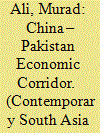

|
|
|
|
|
| Summary/Abstract |
China–Pakistan Economic Corridor (CPEC), a key artery of China’s Belt and Road Initiative (BRI), has attracted the attention of researchers and policymakers within and outside Pakistan. A blend of investment-loan-grant model of over US$ 46 billion, CPEC contains projects aimed at building energy and communication infrastructure and industrial zones. Based on the analysis of primary and secondary data, this study aims to answer two questions: first, what are the main socio-economic or geostrategic prospects of CPEC for Pakistan and China? Second, are there any constraints and challenges in the implementation of CPEC projects and how are these going to be addressed? The paper examines CPEC’s potential in bringing about socio-economic development in Pakistan and its financial and geostrategic significance for China. It also explores key constraints related to the fragile security situation and the potential of CPEC to further exacerbate the geopolitical situation in the region, particularly in South Asia, where it could intensify tension between Pakistan and India as the latter perceives CPEC as a Chinese geopolitical and security project. In addition, the long-term financial implications of CPEC are assessed, with particular focus on its potential to become a debt trap for Pakistan in the long run.
|
|
|
|
|
|
|
|
|
|
|
|
|
|
|
|
| 20 |
ID:
156446
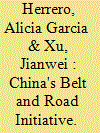

|
|
|
|
|
| Summary/Abstract |
The Belt and Road Initiative (BRI) aims to improve cross-border infrastructure to reduce transportation costs across a massive geographical area between China and Europe. We estimate how much trade might be created among Belt and Road (B&R) countries as a consequence of the reduction in transportation costs (both railway and maritime) and find that European Union countries, especially landlocked countries, will benefit considerably. This is also true for Eastern Europe and Central Asia and, to a lesser extent, South-East Asia. In contrast, if China were to seek to establish a free trade area within the B&R region, EU member states would benefit less, while Asia would infrastructure, is advantageous for Europe as far as trade creation is concerned.
|
|
|
|
|
|
|
|
|
|
|
|
|
|
|
|
|
|
|
|
|